|
During the 1990s multiple specific and distinctive plant abnormalities were repeatedly documented in several hundred different crop formations which had occurred in various European countries as well as in the States and Canada. Extensive laboratory examination of thousands of these crop circle plants and their controls by American biophysicist W. C. Levengood established the presence of consistent changes in the circle plants which were not present in the control plants (plants taken at varying distances outside the crop formations, but in the same fields) -- changes which control studies revealed were not caused by simple mechanical flattening of the plants (with planks, boards, cement rollers or human feet).
For detailed discussion of the plant (and subsequently soil) anomalies documented between 1990-2002, see http://www.bltresearch.com/published.php and http://www.bltresearch.com/xrd.php.
Because some crop formations are known to be mechanically flattened by people (see a vain attempt by some M.I.T. undergraduates in Ohio, in 2002: http://www.bltresearch.com/published/mit.php) circle enthusiasts have long desired simple indicators of the "real McCoy" -- in particular, parameters they could easily recognize while out in the fields. And while we appreciate this desire, the BLT Team's plant and soil research indicates that any reliable determination requires the documentation of multiple plant and/or soil abnormalities -- some of which documentation does require microscopic or other laboratory analysis -- to ascertain with certainty the origin of any specific event.
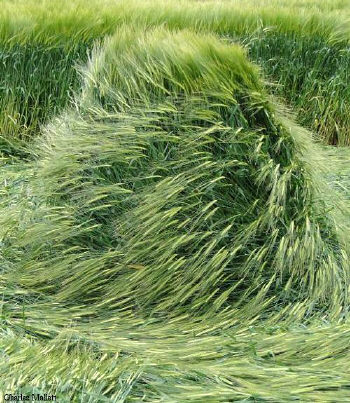 |
|
Fluid "lay" of barley plants inside the June 12th "Phoenix"
formation. Photo: Charles Mallett
|
However, there are four scientifically-documented visible plant changes which are hallmarks of genuine crop circles -- and all of these, if present, are (a) thought to be caused by the exposure of the plants to the heating component (most likely microwave radiation) of a plasma energy discharge which our work indicates is involved in the creation of many crop circles, and (b) except for the inhibited seed/seed-head development, the other three will be present immediately after a formation occurs:
1. |
elongation or stretching of the apical nodes (the first node
beneath the seed-head), as compared to the control nodes.
|
2. |
expulsion cavities (holes blown out at the nodes, usually found
in the 2nd and/or 3rd nodes beneath the seed-head), as compared
to control plants at various distances away from the formation,
(but not along the tramlines).
|
3. |
distinct bending of the plant stems at the nodes, which can
occur at any or all of the nodes -- this parameter is useful only if one
knows both the growth-stage of the crop when the circle occurred
and how much time has elapsed since then, because young and
vigorously-growing plants will produce nodal bending within days
of being flattened (so long as they are not crushed), as they begin to reorient themselves to the sun and to gravity (phototropism and
gravitropism.
Mature crop which has begun to dry down does not have the energy
required for these natural recovery processes and, so, marked node
bending in circles which occur in this later growth-stage is much
easier to recognize as significant.
|
4. |
inhibited seed-head development, which is usually only apparent
in crop formations which have occurred fairly early in the season
but are being examined at least 3-4 weeks later. In early genuine
formations the seed-heads in the flattened crop will usually be visibly
smaller and less well-developed 3-4 weeks later, and in many cases
the glumes have been found to contain no seeds at all.
|
There is a fifth visible plant alteration -- bending at the base of the plant -- which can be also be highly significant but, as in the case of nodal bending, it's significance is dependent upon both the type of plant involved and the age of the crop at the time the formation has appeared. Young cereal plants are quite flexible and when flattened mechanically will often bend at the base rather than break; however, marked bending at the base in certain plants (such as canola, which has a thick stalk which breaks easily) or in older crop, particularly if it has reached the drying stage, is quite likely to be highly significant (since mechanical flattening at this stage will crush, not bend, the plant base).
In addition to the visible changes discussed above the BLT Team has
always (if attempting to determine "authenticity" of a specific crop circle) taken into consideration additional parameters which require lab analysis to estabish. These are (a) marked germination abnormalities in the crop circle seeds; (b) the presence of node-length changes which correlate with the well-known law of physics (the Beer-Lambert principle) which predicts the effect of exposure to EM energies on matter; (c) the presence and distribution patterns of microscopic, magnetized iron spherules in the soils; and (d) after the completion of the x-ray diffraction study in 2002, the increased ordering of the crystalline structure of specific clay minerals in crop circle soils.
We do not have the funding needed to repeatedly replicate the in-depth field and lab work carried out (and published in refereed journals) during the1990s. But since it has been many years since BLT examined UK crop circles we were curious to know if some of the recent British formations continued to exhibit these same visible plant changes documented so thoroughly during the 1990s and which we associate with authenticity.
Because in-depth sampling and subsequent intensive laboratory work was not carried out in 2009 we cannot be 100% certain that the visible plant changes we found are absolute proof these formations were genuine. But an educated estimate can be offered in several instances.
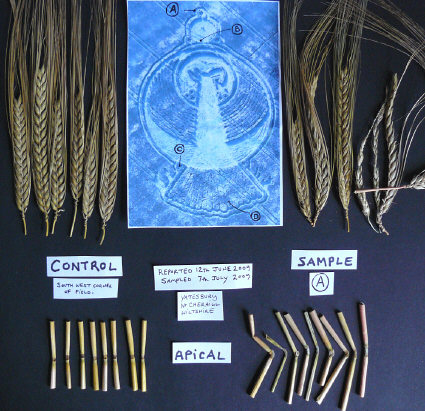 |
|
Sample seedheads from inside the "Phoenix" show clearly retarded development
(as compared to their controls) 25 days after formation appeared,
as well as marked apical node elongation.
|
Randomly-Downed Crop
In the 1990s BLT also regularly sampled plants in areas of randomly-downed crop often found near "geometric" formations and discovered that the plants in these areas frequently contained the same plant changes found in the "geometric" formations themselves -- suggesting that these plants were also exposed to the plasma discharge the evidence indicates was present during the creation of the "geometric" designs. Further, in multiple previous instances where randomly-downed areas have been sampled and tested, the plant abnormalities present have been even more pronounced than those documented in the circles themselves.
In some cases randomly-downed crop is caused by weather damage and, occasionally, by over-fertilization (called "lodging" by farmers) -- but when one is looking at lodging the only visible plant abnormality one could expect to see would be node bending -- and this only if the crop was still vigorously growing when affected and, also, only when enough time has elapsed for the plants' natural recovery processes (phototropism/gravitropism) to cause the node-bending as the plants reorient themselves to the sun and gravity.
In 2009 our British fieldworker examined a number of these randomly-downed or partially-downed areas in the fields -- in particular when they were present close to "pictorial" or "geometric" circles. In the case of the "Phoenix" he found a series of partially-downed "splashes" just above the "head" area of the "Phoenix," and his samples of this area revealed both apical node elongation and expulsion cavities in the 2nd nodes.
Again, it must be noted that apical node elongation and expulsion cavities were not found in the controls taken from standing crop near the SW corner of the field.
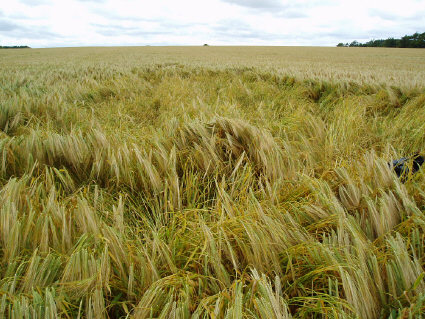 |
|
A randomly-downed area of barley found near one end of the "Phoenix." Partially-
flattened and/or non-geometric flattening like this does, in some cases,
show the same plant effects as are found in the formations.
|
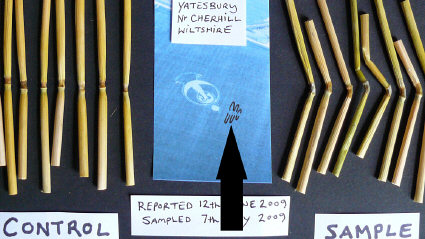 |
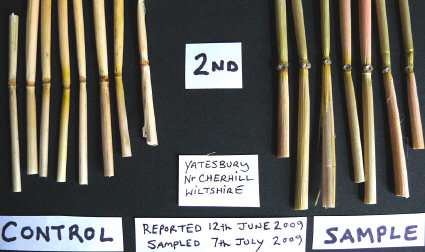 |
|
Elongted apical nodes (top) & expulsion cavities (bottom) in the 2nd nodes
in randomly-downed "splashes" near "Phoenix."
|
A Los Angeles TV crew--the same group which discovered the "Mayan Mask" opposite Silbury Hill (see Part 2) -- reports that the "Dragonfly" formation discovered on June 3rd in this same field was "full of blown nodes," which they carefully filmed. And, although our fieldworker did not examine the "Dragonfly," a photo posted on the Crop Circle Connector (http://www.cropcircleconnector.com/) shows a massively elongated apical node (with equally extreme node bending) in a plant which apparently came from the "Dragonfly" shortly after it's discovery. If that plant was typical of the rest of the downed crop inside the "Dragonfly" (and with the film documentation of expulsion cavities throughout) there could be no doubt of that formation's authenticity.
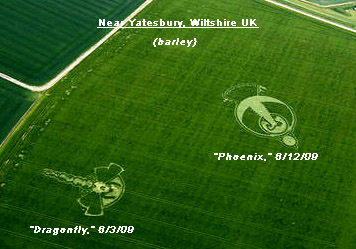 |
|
Two highly-interesting June '09 formations in same field
near Yatesbury. Photo: Frank Laumen
|
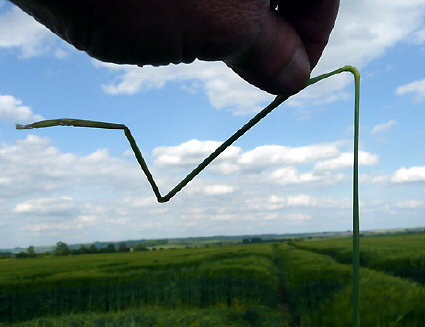 |
|
Massive apical node elongation and marked nodal bending in plant from June 3rd
"Dragonfly." Film crew reports the formation was also "full of blown nodes,"
plant changes which are not caused by mechanical flattening.
Photo: Mark Vidler
|
Is a Consciousness of Some Kind Involved?
In June 2009 two of our European colleagues spent a few days in Wiltshire, examining several of the formations which had already appeared. These colleagues have considerable experience in the UK fields and were not only surprised by the new "pictorial" design style so much in evidence in 2009, they were not at all sure how to evaluate the "lay" quality observed in some of these formations, particularly in the "Dragonfly."
On the night of June 11th, while walking along the farm track next to the "Dragonfly," they found themselves wishing for a new formation to arrive that night in the same field, near the "Dragonfly" -- and what they discussed was a fairly simple "geometrical" design, perhaps a plain circle but with some sort of "special feature" which they might be able to recognize as a "response" to their wish. Specifically, they talked about a piece of this simple circle being "moved outwards," and there being a standing section like a "slice of cake."
The next morning (June 12th) the "Phoenix" was discovered in the Yatesbury field in a spot directly opposite the place where our colleagues had been standing in the farm-track next to the field when they "wished" for a simple design to appear. But it, of course, could hardly be considered a "simple" design...and it was clearly as "pictorial" as the "Dragonfly."
But on the following day another new formation was found just below Milk Hill, near Stanton St. Bernard. This formation was both smaller and of a much simpler design and it was also mostly symmetrical. Both men were shocked when they discovered the protruding outer ring around one of the six circles and the small triangularly-shaped section of standing crop in this same circle, immediately recalling their request two days previously for a special feature: "one section of the circle should be moved outwards," and there should also be a standing feature "like a slice of cake."
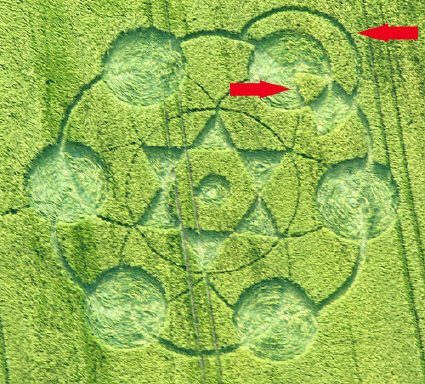 |
|
June 13th formation below Milk Hill, with geometric "aberrations" (arrows, upper R)
which seem to precisely reflect those specifically requested.
Photo: John Montgomery
|
As many have wondered over the years when specific design elements have appeared after being imagined or actually requested, or crop circles have occurred in precise locations privately thought to be "a perfect place for a cropcircle," our two colleagues here -- both basically of a skeptical bent -- could not help pondering whether it could possibly be that someone, or something, was listening? And not only listening, but answering?
In this case the "Phoenix" formation appeared the very next day and in almost the exact spot these men had wished that a new formation would appear -- but its overall design was totally unlike what had been desired. And then, the following day but in another location entirely, another new and much simpler design did appear -- and this time did include a "special feature" -- one which certainly looks like the precise design anomaly which they had discussed out loud two days earlier.
With no prior knowledge of this set of circumstances related to the June 13th Milk Hill formation, our 2009 UK fieldworker just happened upon it on his second trip to Wiltshire early in July, and he sampled it 26 days after it had formed. Here's what he found:
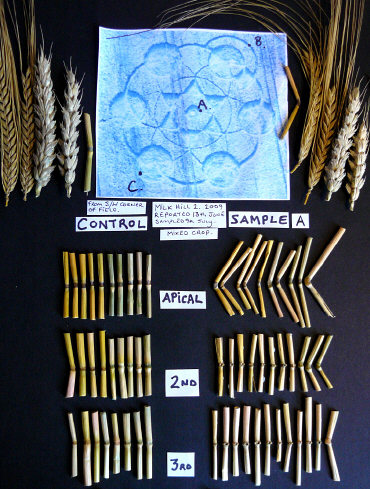 |
|
June 13th Milk Hill formation with precise design anomalies requested
two days earlier. Formation occurred in section of field
which contained both wheat and barley.
|
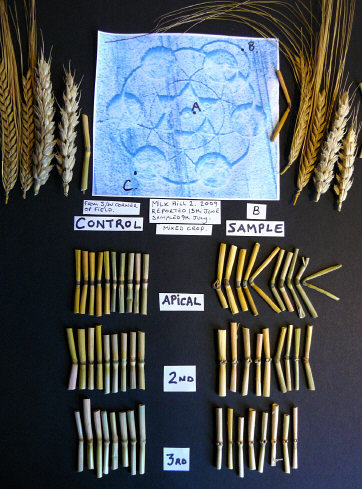 |
|
Sample B (from "anomalous" extended ring area) also showed marked
plant abnormalities in all 3 nodes.
|
Even with only three sets of samples and controls we can be very close to certain -- with clearly visible apical node elongation in nearly all the samples and expulsion cavities not only in nearly every 2nd but also 3rd node--that this formation was not flattened with planks or boards. It may be that the question here should be more along the lines of "could it possibly be that someone or something really WAS listening?"
A Small, Two-Phase Formation
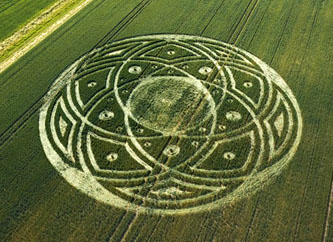 |
|
2-phase formation at Honey Street. Center circle appeared on
June 27th; elaborate addition on July 6th.
Photo: Steve Alexander
|
Another of the relatively small (as compared to some other formations which appeared in 2009) crop circles -- but one which occurred in two phases -- is more difficult to evaluate. Our fieldworker did sample both phases on July 10th, with both samples from the first phase (center circle) showing only moderate apical node lengthening but definite expulsion cavities in most of the 2nd and 3rd nodes.
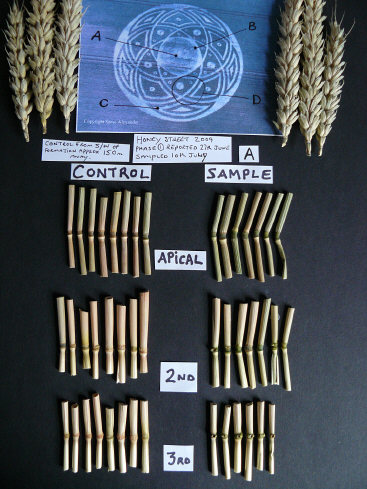 |
|
Sample A from phase #1 of Honey Street formation shows no obvious
change in seed-head development and only moderate apical
node lengthening, but expulsion cavities in
2nd and 3rd nodes.
|
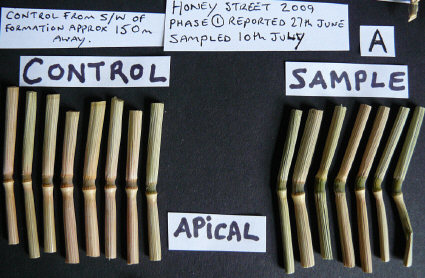 |
 |
|
Moderate apical node elongation & expulsion cavities in 3rd node
beneath seed-head in plants from center circle.
|
 |
 |
|
Sample B from center circle shows slightly greater apical node-length
elongation and expulsion cavities in 2nd nodes.
|
Changes in plant samples from phase #2 of the Honey Street formation (Samples C & D) show what may be slight apical node elongation -- and a few expulsion cavities are present in some of the 2nd and 3rd nodes -- but the changes here are markedly less clear than in phase #1.
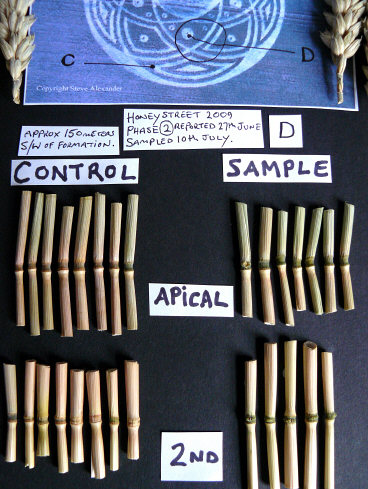 |
|
Slight apical node change in Sample D, from phase #2.
One expulsion cavity is present in apical nodes.
|
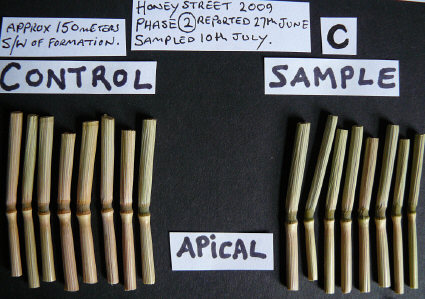 |
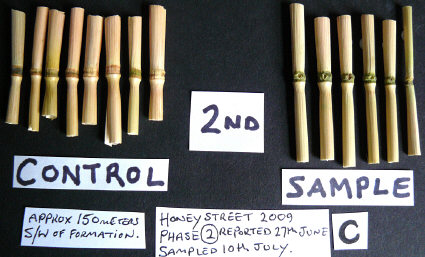 |
|
Again, apical node lengthening is not certain in Sample C from
phase #2; expulsion cavities are present in 2nd nodes.
|
The sample size is not large enough in phase #2 to reach any reliable conclusion. It is possible here that the time difference between when the two phases appeared in the field and sampling was carried out (phase #1=14 days, phase #2=5 days) is of significance. As the plants dry down the apical node-length increase, when present, becomes more apparent (this also applies, of course, to the controls). So, when there is significant node-elongation it is often easier to see (and to measure) once the plants have dried down fully.
We thought it would also be helpful to note Charles Mallett's usually very reliable field observations regarding this formation: he states he observed a "significant number" of biological anomalies ("blown" nodes and/or elongated nodes) in Phase #2 (http://www.silentcircle.co.uk/rpt092.html).
Two final points needs to be made. Based on the data derived from the crop circle research carried out by BLT in the 1990s it is clear that there is some degree of variation in the discharge intensity level of each interacting component of the energy system involved in creating genuine crop circles. In some circles it has been clear that the heat discharge, although very brief in all cases, was quite intense--whereas in other formations the degree of heat seems to have been relatively mild. It is also clear that the magnetic field strength and electrical component vary from case to case, and can even vary from one location to another in a single formation (a situation which then requires an enormous sampling effort in very large, complex events such as those occurring in recent years).
There is also substantial evidence of what we have termed a "spillover" effect in some of the larger formations during the '90s, with standing crop outside the formations showing exposure effects up to several hundred feet outside the downed-crop perimeters. And in fields in which very large formations occur, or multiple circles form in one summer, there is a distinct possibility that the entire field will have been affected.
The circle phenomenon is very complex...and so all of the facts established so far (and likely others which have not yet been discovered) must be taken into account when attempting to evaluate "authenticity" of any given event.
Continue to Part 2 >>
|